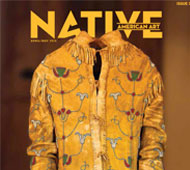Adobe Gallery Blog
Tradition and Innovation, Santa Clara artists Pablita Velarde and Helen Hardin
Mother-daughter artists Pablita Velarde and Helen Hardin drew from the traditions and imagery of their cultures in the expression of their distinctive yet similar works. At least 19 original paintings from the renowned painters are on view through April 30 at Adobe Gallery in Santa Fe, New Mexico, a celebration of the wide range of styles that the artists employed during their careers.
Velarde (1918-2006), born as “Tse Tsan” or “Golden Dawn” at the Santa Clara Pueblo in New Mexico, was known for her earth paintings. She used mineral and rock elements grounded on a metate and mano, resulting in a powdery substance that was the matter used in her paints. Velarde painted almost exclusively on paper supports, using watercolor and casein in addition to earth pigments, according to the gallery. For years, she worked in a studio she built herself, primarly with pigments she made herself.
Hardin (1943-1984), known as “Tsa-Sah-Wee-Eh” or “Little Standing Spruce,” in the Tewa language, was one of the pre-eminent painters of the 20th century. She saw her style emerge in the 1970s with katsina figure paintings. Her Woman Series works are considered deeply affective and concerned with the physical and intellectual struggle of the artist’s existence. As the gallery describes further, it is “the struggle of woman versus man, patron versus artist, Indian versus Anglo, tradition versus progression, an art of complexity and timeless beauty, a forward looking art yet rooted firmly in the ancient past.”
Al Anthony, owner of Adobe Gallery, says Hardin’s Santo Domingo Garden Bird represents the bird figure that the Santo Domingo artists place on their pottery. “I think maybe Helen just liked it and chose to use it,” he elaborates. “Acoma paint parrots on some of their pots. A lot of artists have reproduced the Acoma parrot.”
Remarkably different in style, Velarde’s Zuni Shalako Ceremony Witnessed by a Santa Clara Artist shows a view of the namesake Zuni ceremony occurring during the first week of December. A written description from the Ball State University website explains the process of preparing for Shalako: “The participants have been practicing all year to perform their duties; seven new houses have been built to welcome the Shalakos (the Giant Couriers of the Rainmakers) and the Longhorns (Rain Gods of the North), and an enormous amount of food is prepared for both residents and visitors. Shalako brings the old year to a close and welcomes the new year, and asks for rain, the propagation of plants and animals, and the health and well-being of its participants. It is also a re-enactment of various important tribal myths.”
Anthony describes it as an all-night, eight-day ceremony, with a public portion in the last day.
“It is basically the blessing of new homes, or remodeled homes,” he continues. “There are usually about four Shalakos, they are representing Gods. They are supernaturals. They are about 10 feet tall. When they build a new house, before they finish it, they leave the living room, or the one big room. They dig the floor down about 4 feet from ground level...They have to do that in order to accommodate their height.”
Anthony continues, “The next morning around sunrise, they have a race down the river. If one of them falls, they figure that is an omen of a disaster for the year. They’re human inside, holding up these 10-foottall structures.”
Ann Marshall, director of curation and education at the Heard Museum in Phoenix, remarks that the work of both artists “demonstrates a joy in experimenting with media and style. It is a quality of the best artists that they refuse to repeat a successful formula, but move on to explore new ways to express their vision.”

As seen in:
Native American Art, April-May 2016

